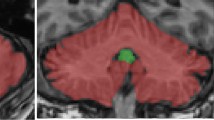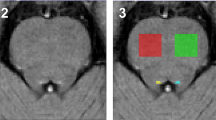Abstract
Camptocormia is characterized by an excessive anterior flexion of the spine that appears only when standing or walking. The origin of this symptom remains unknown, but recent clinical reports of camptocormia associated with Parkinson’s disease (PD) suggest cerebral involvement in the pathogenesis of camptocormia. This study was undertaken to investigate the hypothesis that camptocormia in PD has a central origin. Seventeen PD patients with camptocormia were prospectively enrolled and were compared to 10 matched PD patients without camptocormia and 12 normal controls. The normalized volumes of the brain, striatal nuclei, and the cross-sectional areas of the midbrain and pons were measured on three-dimensional magnetic resonance imaging. Data were correlated with the severity of the symptoms. The normalized axial surface of the midbrain was statistically smaller in PD patients with camptocormia than in normal controls (P = 0.01). The normalized volumetric data were not statistically different in PD patients with camptocormia. There was a significant negative correlation between the severity of camptocormia and the normalized brain volume (P < 0.009; R = −0.649) and sagittal pons area (P < 0.01; R = −0.642). The results suggest that PD with camptocormia may represent a selective form of PD in which a specific neuronal dysfunction possibly occurs within the brainstem.





Similar content being viewed by others
References
Souques A, Rosanoff-Saloff M (1914) La camptocormie: incurvation du tronc consecutive aux traumatismes du dos et des lombes; considérations morphologiques. Rev Neurol 28:937–939
Sandler SA (1945) Camptocormia: a functional condition of the back in neurotic soldiers. War Med 8:36–45
Perez-Sales P (1990) Camptocormia. Br J Psychiatry 157:765–767
Onuaguluchi G (1961) Crises in post-encephalitic parkinsonism. Brain 84:395–414
Inzelberg R, Hattori N, Nisipeanu P et al (2003) Camptocormia, axial dystonia, and parkinsonism: phenotypic heterogeneity of a parkin mutation. Neurology 60:1393–1394
Diederich NJ, Goebel HH, Dooms G et al (2006) Camptocormia associated with focal myositis in multiple-system atrophy. Mov Disord 21:390–394
Slawek J, Derejko M, Lass P, Dubaniewicz M (2006) Camptocormia or Pisa syndrome in multiple system atrophy. Clin Neurol Neurosurg 108:699–704
Bloch F, Houeto JL, Tezenas du Montcel S et al (2006) Parkinson’s disease with camptocormia. J Neurol Neurosurg Psychiatry 77:1223–1228
Lepoutre AC, Devos D, Blanchard A et al (2006) A specific clinical pattern of camptocormia in Parkinson’s disease. J Neurol Neurosurg Psychiatry 77:1229–1234
Charpentier P, Dauphin A, Stojkovic T et al (2005) Parkinson’s disease, progressive lumbar kyphosis and focal paraspinal myositis. Rev Neurol (Paris) 161:459–463
McCluskey LF (2006) Camptocormia: pathogenesis, classification, and response to therapy. Neurology 66:1285–1286, author reply 1285–1286
Azher SN, Jankovic J (2005) Camptocormia: pathogenesis, classification, and response to therapy. Neurology 65:355–359
Delisle MB, Laroche M, Dupont H, Rochaix P, Rumeau JL (1993) Morphological analyses of paraspinal muscles: comparison of progressive lumbar kyphosis (camptocormia) and narrowing of lumbar canal by disc protrusions. Neuromuscul Disord 3:579–582
Slawek J, Derejko M (2001) Camptocormia, a rare form of motor system disorders in Parkinson’s disease. Neurol Neurochir Pol 35:1133–1140
Laroche M, Delisle MB, Aziza R, Lagarrigue J, Mazieres B (1995) Is camptocormia a primary muscular disease? Spine 20:1011–1016
Yamada K, Goto S, Matsuzaki K et al (2006) Alleviation of camptocormia by bilateral subthalamic nucleus stimulation in a patient with Parkinson’s disease. Parkinsonism Relat Disord 12:372–375
Djaldetti R, Mosberg-Galili R, Sroka H, Merims D, Melamed E (1999) Camptocormia (bent spine) in patients with Parkinson’s disease–characterization and possible pathogenesis of an unusual phenomenon. Mov Disord 14:443–447
Reichel G, Kirchhofer U, Stenner A (2001) Camptocormia–segmental dystonia. Proposal of a new definition for an old disease. Nervenarzt 72:281–285
Nandi D, Parkin S, Scott R et al (2002) Camptocormia treated with bilateral pallidal stimulation. J Neurosurg 97:461–466
Slawek J, Derejko M, Lass P (2003) Camptocormia as a form of dystonia in Parkinson’s disease. Eur J Neurol 10:107–108
Micheli F, Cersosimo MG, Piedimonte F (2005) Camptocormia in a patient with Parkinson disease: beneficial effects of pallidal deep brain stimulation. Case report. J Neurosurg 103:1081–1083
Nieves AV, Miyasaki JM, Lang AE (2001) Acute onset dystonic camptocormia caused by lenticular lesions. Mov Disord 16:177–180
Litvan I, Bhatia KP, Burn DJ et al (2003) Movement Disorders Society Scientific Issues Committee report: SIC Task Force appraisal of clinical diagnostic criteria for parkinsonian disorders. Mov Disord 18:467–486
Fahn S, Elton R, Members of the UPDRS Development Committee (1987) Unified Parkinson’s disease rating scale. Macmillan Healthcare Information, Florham Park, NY
Bonneville F, Welter ML, Elie C et al (2005) Parkinson disease, brain volumes, and subthalamic nucleus stimulation. Neurology 64:1598–1604
Cointepas Y, Mangin J, Garnero L, Poline J, Benali H (2001) Brain VISA: software platform for visualization and analysis of multi-modality brain data. Neuroimage 13:S98
Oba H, Yagishita A, Terada H et al (2005) New and reliable MRI diagnosis for progressive supranuclear palsy. Neurology 64:2050–2055
Kato H, Izumiyama M, Izumiyama K, Takahashi A, Itoyama Y (2002) Silent cerebral microbleeds on T2*-weighted MRI: correlation with stroke subtype, stroke recurrence, and leukoaraiosis. Stroke 33:1536–1540
Whitwell JL, Crum WR, Watt HC, Fox NC (2001) Normalization of cerebral volumes by use of intracranial volume: implications for longitudinal quantitative MR imaging. AJNR Am J Neuroradiol 22:1483–1489
Ghaemi M, Hilker R, Rudolf J, Sobesky J, Heiss WD (2002) Differentiating multiple system atrophy from Parkinson’s disease: contribution of striatal and midbrain MRI volumetry and multi-tracer PET imaging. J Neurol Neurosurg Psychiatry 73:517–523
Nicoletti G, Fera F, Condino F et al (2006) MR imaging of middle cerebellar peduncle width: differentiation of multiple system atrophy from Parkinson disease. Radiology 239:825–830
Righini A, Antonini A, De Notaris R et al (2004) MR imaging of the superior profile of the midbrain: differential diagnosis between progressive supranuclear palsy and Parkinson disease. AJNR Am J Neuroradiol 25:927–932
Paviour DC, Price SL, Jahanshahi M, Lees AJ, Fox NC (2006) Longitudinal MRI in progressive supranuclear palsy and multiple system atrophy: rates and regions of atrophy. Brain 129:1040–1049
Garcia-Rill E, Homma Y, Skinner RD (2004) Arousal mechanisms related to posture and locomotion: 1. Descending modulation. Prog Brain Res 143:283–290
Black KJ, Ongur D, Perlmutter JS (1998) Putamen volume in idiopathic focal dystonia. Neurology 51:819–824
Hu MT, Chaudhuri KR, Jarosz J, Yaguez L, Brooks DJ (2002) An imaging study of parkinsonism among African-Caribbean and Indian London communities. Mov Disord 17:1321–1328
Camicioli R, Moore MM, Sexton G, Howieson DB, Kaye JA (1999) Age-related brain changes associated with motor function in healthy older people. J Am Geriatr Soc 47:330–334
Bryan RN, Cai J, Burke G et al (1999) Prevalence and anatomic characteristics of infarct-like lesions on MR images of middle-aged adults: the atherosclerosis risk in communities study. AJNR Am J Neuroradiol 20:1273–1280
Sibon I, Fenelon G, Quinn NP, Tison F (2004) Vascular parkinsonism. J Neurol 251:513–524
Hilliquin P, Menkes CJ, Laoussadi S, Job-Deslandre C, Serratrice G (1992) Camptocormia in the elderly. A new entity by paravertebral muscle involvement? Rev Rhum Mal Osteoartic 59:169–175
Schabitz WR, Glatz K, Schuhan C et al (2003) Severe forward flexion of the trunk in Parkinson’s disease: focal myopathy of the paraspinal muscles mimicking camptocormia. Mov Disord 18:408–414
Babat LB, McLain RF, Bingaman W et al (2004) Spinal surgery in patients with Parkinson’s disease: construct failure and progressive deformity. Spine 29:2006–2012
Hadar H, Gadoth N, Heifetz M (1983) Fatty replacement of lower paraspinal muscles: normal and neuromuscular disorders. AJR Am J Roentgenol 141:895–898
Penisson-Besnier I, Menei P, Dubas F, Bregeon C (1994) Histological demonstration of the process of paraspinal muscle denervation in a case of reducible lumbar kyphosis (camptocormia). Rev Rhum Ed Fr 61:868–870
Acknowledgements
We are grateful to the nurses of the Centre d’investigation clinique for the patient care and to Dr. David Seidenwurm for his constructive review of the manuscript.
Author information
Authors and Affiliations
Corresponding author
Rights and permissions
About this article
Cite this article
Bonneville, F., Bloch, F., Kurys, E. et al. Camptocormia and Parkinson’s disease: MR imaging. Eur Radiol 18, 1710–1719 (2008). https://doi.org/10.1007/s00330-008-0927-8
Received:
Revised:
Accepted:
Published:
Issue Date:
DOI: https://doi.org/10.1007/s00330-008-0927-8




